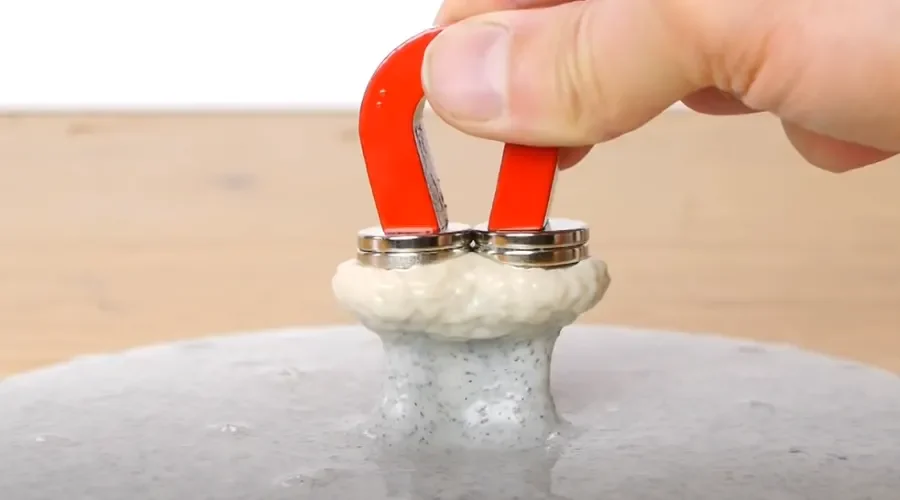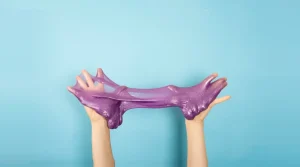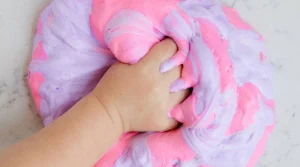
What Do Slime Toys Do? The Science and Learning Behind Slime
Curious about slime toys? Learn what they do and how they help children learn, create, and develop essential skills naturally.
#1 Toys Manufacturer in China. WhatsApp: +86 180-0088-4063. Email: [email protected]
#1 Toys Manufacturer in China. WhatsApp: +86 180-0088-4063. Email: [email protected]

Magnetic slime isn’t just gooey fun—it’s a hands-on way to explore real science. In this blog, we’ll dive into what makes magnetic slime move, how it’s made, and why it reacts to magnets. Whether you’re a curious learner or an educator, get ready to uncover the science behind the slime!
>> Start A Successful Slime Business: How to Sell Slime Online
Magnetic slime is a stretchy, moldable substance that reacts to magnets. It looks like regular slime at first, but it has a surprising twist—it can move or shift when placed near a strong magnet. This makes it a fun material for both play and learning.
Slime is made from a chemical reaction between glue (usually polyvinyl acetate) and an activator like borax or saline solution. The reaction creates long chains of molecules called polymers. These tangled chains give slime its soft, squishy texture and allow it to stretch and bounce.
Different recipes can change how the slime feels—some make it fluffier, stretchier, or firmer. But in all cases, it’s the polymer structure that makes slime behave the way it does.
The big difference is in the added ingredient: iron oxide powder. When this black powder is mixed into slime, it gives the slime magnetic properties. That means it can respond to magnets—especially strong neodymium magnets.
The iron particles don’t stick to the slime chemically. Instead, they are suspended throughout the material. So when a magnet comes close, the tiny bits of iron try to move toward it, pulling the slime along.
You won’t see this effect with a fridge magnet. It takes a much stronger magnetic field to get a visible reaction.
Magnetic slime first gained attention in science classrooms as a hands-on way to teach kids about magnetism and materials. It was also used in labs to demonstrate how ferromagnetic particles behave in non-solid materials.
Later, YouTube creators and educators helped it go viral by showing slime that “chased” magnets or “ate” metal objects. But long before it was a trend, magnetic slime had a quiet place in science kits and educational workshops as a creative way to explore physics and chemistry.
At first glance, magnetic slime just looks like dark, stretchy goo. But behind the movement is a bit of real science. Magnetic slime doesn’t move by magic—it reacts to forces around it, especially those from magnets.
The key ingredient in magnetic slime is iron oxide powder, often magnetite (Fe₃O₄). These are tiny, ferromagnetic particles. That means they can be pulled by a magnetic field. When mixed into slime, the particles stay suspended in the sticky polymer base.
Each particle acts like a tiny compass needle. By themselves, they don’t do much. But when a strong magnet gets close, the particles respond all at once, pulling the slime in that direction. The more iron oxide you add, the stronger the effect.
Slime is a non-Newtonian fluid. It flows like a liquid under gentle pressure but behaves like a solid when forced quickly. That’s important when a magnet is involved.
When a magnet is placed near the slime, it pulls on the iron oxide inside. The slime itself isn’t magnetic—but the particles are. As the magnet attracts the particles, the surrounding slime stretches and moves with them.
This happens slowly. The slime doesn’t jump toward the magnet like a piece of metal would. Instead, it creeps or flows, like it’s crawling. That’s because of its thick, sticky texture.
The motion is a result of force being applied unevenly. When a magnet is held near the slime, the side with the most particles facing the magnet feels the strongest pull. The iron-rich part starts to stretch toward the field.
Over time, the rest of the slime follows because it’s sticky and connected. The particles “pull” the slime along with them. This can create fun effects—like slime that seems to “eat” a magnet or climb up toward it.
The speed depends on the slime’s thickness, the amount of iron oxide, and the magnet’s strength. A weak fridge magnet won’t do much. A neodymium magnet creates a clear, visible reaction.
Some people think magnetic slime is magnetic on its own. It’s not. It can’t hold a magnetic charge. It only reacts when a magnet is nearby.
Another myth is that the slime contains tiny magnets. It doesn’t. The iron oxide inside only acts magnetic when exposed to a magnetic field. Once the magnet is gone, the slime stops moving.
Also, magnetic slime is not dangerous—but it’s not meant to be eaten or left near electronics. The iron powder inside is fine in small amounts but should always be handled with care, especially by young kids.
Magnetic slime isn’t just a fun science toy—it’s an experiment in chemistry and physics. The unique properties of this slime come from its ingredients, and how they work together at the molecular level. Let’s break down the key components that make magnetic slime tick.
The base of any slime, including magnetic slime, is usually made from a combination of polymers. A common choice is polyvinyl alcohol (PVA), which is a synthetic polymer. When mixed with a cross-linking agent like borax (sodium tetraborate), the PVA molecules form a network of connections. This makes the slime thick and gooey, giving it that stretch and flow we all love.
What makes magnetic slime different is the addition of another ingredient: iron oxide powder, typically magnetite. This powder is responsible for the magnetic properties. But how do the slime and iron oxide work together to create the unique movement?
When iron oxide powder is mixed into the slime, it doesn’t dissolve. Instead, the tiny particles are suspended in the polymer matrix. These particles are ferromagnetic, which means they are attracted to magnetic fields. Iron oxide particles are much smaller than a grain of sand, and because they’re suspended in the slime, they move freely within the sticky matrix.
When you bring a magnet close, the magnetic field interacts with the particles, causing them to align in a certain direction. This creates a force that stretches or pulls the slime toward the magnet. The flexibility and sticky nature of the slime allow it to “flow” and “move” in response to the force, without breaking apart or losing its consistency.
The interaction between the iron particles and the polymer matrix is a result of the magnetic field’s force on the iron oxide. The polymer chains hold the particles in place, allowing them to shift and move as the magnetic field directs them.
These interactions not only make the slime fun to play with, but they also provide a hands-on way to demonstrate magnetic fields and non-Newtonian fluids. The slime’s consistency and texture change depending on the strength of the magnetic field, providing a tangible and fascinating demonstration of chemistry in action.
Magnetic slime moves because of something called a magnetic field. A magnetic field is an invisible force that magnets create. It’s like an invisible map of where the magnet can pull or push things. When you bring a magnet close to magnetic slime, the field lines from the magnet act on the tiny iron particles inside the slime.
Imagine the magnet is like a flashlight, and the field lines are beams of light. Wherever the light shines, the slime follows. The iron particles inside the slime can “see” these invisible beams, and they want to follow them. As a result, the slime stretches and moves toward the magnet, just like a toy car moves towards a ramp.
This simple interaction is a great way to see how magnets work! When the magnetic field pulls on the iron particles, the slime changes shape and shifts, creating a fun and educational experience. It’s like the slime is dancing to the beat of the magnetic field!
Magnetic slime is an exciting and engaging toy, but it’s essential to consider safety when introducing it to children. Although magnetic slime is generally safe for kids, there are some important guidelines to follow to ensure it’s used properly and without risk.
Most magnetic slime is made with non-toxic ingredients like PVA glue, baking soda, and iron oxide powder, making it safe for children. However, it’s crucial to verify that the product is labeled as child-safe and adheres to safety standards.
Additionally, parents should be aware of the magnetic particles inside the slime, which can be a choking hazard if swallowed.
Because of this, magnetic slime is typically recommended for children aged 5 and older. Always check the product’s age recommendations before letting younger children play with it.
When handling magnetic slime, it’s important to supervise play, especially if younger children are involved.
Educators and parents should explain that the slime should never be eaten or placed in the mouth. It’s also a good idea to keep magnets away from electronics, credit cards, or medical devices like pacemakers, as strong magnets can interfere with them.
To prevent a mess, ensure that children play with magnetic slime in an easy-to-clean area, like on a plastic tray or surface.
Magnetic slime should be stored in an airtight container to prevent it from drying out. Since it contains small metal particles, it’s important to keep it away from other magnetic objects that could attract and damage it.
The container should be kept in a cool, dry place, out of direct sunlight, and away from heat sources. Always ensure the slime is sealed well when not in use, as this will help it maintain its consistency and magnetic properties longer.
Making magnetic slime at home can be a fun and educational experiment. Not only will you learn about the properties of magnets and slime, but you’ll also get to witness the magical effect of magnetic slime right in front of your eyes.
To make your own magnetic slime, you’ll need some basic ingredients. Here’s a quick list:
These ingredients combine to create a slime that’s both stretchy and magnetic, allowing it to be manipulated by a magnet.
>> Easy DIY: How to Make Magnetic Slime
To ensure your magnetic slime works properly, it’s important to get the right consistency and enough iron oxide powder in the mix. Here are some tips for success:
Making magnetic slime at home is a fun process, but there can be a few hiccups along the way. Here’s how to fix some common issues:
With a little patience and practice, you’ll have a batch of magnetic slime that’s perfect for exploration and play!
Magnetic slime is not only a fun sensory activity but also a great tool for learning. By using it in the classroom or at home, children can explore basic scientific concepts in a hands-on way.
Magnetic slime is an excellent material for demonstrating basic principles of magnetism. Simple experiments can help kids understand how magnetic fields work and how magnets interact with different materials.
These experiments help students grasp the abstract concepts of magnetism in a fun, interactive way.
Magnetic slime offers an opportunity for children to build critical thinking skills. It encourages them to explore, ask questions, and make predictions based on their observations. Through trial and error, kids can discover how the slime reacts to different variables, such as:
Encouraging students to ask “What if?” questions fosters creativity and problem-solving skills. They might even design their own experiments, hypothesizing how different factors will affect the slime’s behavior. This hands-on approach to learning makes science tangible and exciting.
Magnetic slime can also be a valuable resource in STEM (Science, Technology, Engineering, and Mathematics) education. By using it in various learning activities, kids can explore multiple STEM concepts:
By integrating magnetic slime into STEM lessons, students get a deeper, interactive understanding of the world around them while having fun with a fascinating material.
Slime comes in many different forms, each offering unique textures, colors, and properties. While magnetic slime is fascinating for its interaction with magnets, it’s essential to understand how it compares to other popular slimes, such as fluffy, clear, and butter slime.
Magnetic Slime: The defining feature of magnetic slime is its magnetic properties. It contains iron oxide particles that allow it to interact with magnets. When a magnet is brought close, the slime moves and stretches in unique ways. This gives it a more solid, dough-like texture compared to other slimes. Magnetic slime can be thick and sticky, providing a tactile experience when manipulated.
Fluffy Slime: Known for its light, airy texture, fluffy slime is made by adding shaving cream or foam beads to the basic slime mixture. While it doesn’t have magnetic properties, fluffy slime is popular for its soft, pillowy feel and stretchiness. It’s light and perfect for sensory play, providing a different sensory experience compared to the thicker, denser texture of magnetic slime.
Clear Slime: Clear slime is made with transparent glue and is best known for its glass-like appearance. It’s smooth and stretchy, offering a soft and slick feel. Unlike magnetic slime, clear slime is non-reactive to magnets but provides an excellent base for sensory play, especially when combined with various colors and glitter for visual appeal.
Butter Slime: This type of slime incorporates clay to give it a smooth, buttery texture. It’s soft, moldable, and less sticky than magnetic slime. Butter slime doesn’t have any magnetic properties but offers a smooth and smooth tactile experience, making it ideal for sensory exploration and squishing activities.
When it comes to sensory feedback, each type of slime offers its unique feel and response. Magnetic slime stands out because of its reaction to magnets. The movement and stretchiness of the slime when a magnet is applied make it highly engaging. The experience is dynamic, and children can experiment with different magnets to see how the slime behaves.
Fluffy slime, on the other hand, provides an excellent sensory experience due to its light, airy texture. It’s fun to squish and stretch and offers a unique tactile sensation. Clear slime’s slick, gooey feel is also highly satisfying to the touch, providing a calming experience when played with. Butter slime provides a smooth and soft sensory experience, ideal for those who enjoy a buttery, less sticky texture.
However, for hands-on learning, magnetic slime provides the most interactive sensory experience, especially when used in science experiments and demonstrations.
The type of slime you choose depends on your goal. If you’re looking to explore scientific concepts like magnetism, magnetic slime is your best choice. It allows children to interact with magnets and see the effects firsthand, fostering curiosity and critical thinking.
For purely sensory play, fluffy slime or butter slime might be better suited. These types of slimes are perfect for children who enjoy tactile exploration and need a soft, malleable material to engage with.
If the goal is visual stimulation or simple play without a specific educational focus, clear slime is an excellent option. It’s ideal for those who love to manipulate smooth, transparent materials, especially with added textures like glitter or beads.
Magnetic slime, like other types of slime, can change over time due to its unique ingredients and the interaction of its components. Understanding how it behaves as it ages can help you maintain its optimal performance and know when it’s time to replace or discard it.
As magnetic slime ages, several factors can cause it to change. The most noticeable change is in its texture. Over time, the slime may become drier, stickier, or lose its smooth consistency. This happens because the moisture in the slime slowly evaporates or is absorbed, leaving behind a more solid and less stretchable material.
The iron oxide particles that give magnetic slime its magnetic properties can also begin to separate from the slime matrix as it ages. This separation may cause the slime to lose some of its magnetic response, resulting in less dramatic movements when a magnet is applied. The slime may also become harder to stretch or more difficult to manipulate.
If the slime has been exposed to air or stored improperly, the magnetic particles might clump together, affecting its ability to react smoothly to magnets. While this doesn’t always mean the slime is unusable, it does reduce the fun and interactive experience.
It’s essential to monitor the condition of your magnetic slime. If you notice the texture becoming too hard, dry, or sticky, it might be time to replace it. If the slime’s magnetic reaction is significantly weaker or non-existent, this is another indication that the slime has reached the end of its useful life.
Magnetic slime should be discarded if it has an unpleasant smell, has developed mold, or has become overly hardened. It’s also a good idea to replace the slime if it’s no longer safe for children to play with due to its compromised texture.
To prolong the life of your magnetic slime, store it in an airtight container and keep it in a cool, dry place. Proper storage will help maintain its texture and magnetic properties, allowing you to enjoy it for a longer period before any noticeable deterioration occurs.
Magnetic slime is a unique and engaging material that blends the worlds of science and play. By understanding the role of iron oxide particles and how magnets interact with the slime, we gain insight into magnetism and material properties. Whether for educational purposes or fun experiments, magnetic slime offers endless learning opportunities.
>> How to Find the Right Toy Manufacturer: A Comprehensive Guide
Yes, you can use various types of magnets with magnetic slime, but stronger magnets like neodymium magnets work best to create noticeable movement. They provide a more powerful magnetic field that significantly affects the slime's behavior.
Magnetic slime usually doesn't change color when interacting with magnets. However, certain additives like metallic particles or color-changing pigments can cause the slime to shift color when exposed to magnetic fields, adding another layer of intrigue to the experience.
Yes, magnetic slime can be shaped into sculptures that respond to magnets. By positioning magnets underneath or near the slime, you can create moving shapes, allowing for a unique, interactive sculpture. The slime's ability to "crawl" toward the magnet adds a fun, dynamic element.
Magnetic slime can last for a long time if properly stored. However, over time, exposure to air and handling may affect its texture, and the iron particles may lose some magnetic properties. Keeping it sealed in an airtight container helps preserve its magnetism and consistency.
Magnetic slime can be mixed with other types of slime, but the magnetic properties may weaken depending on the mixture. If you mix it with non-magnetic slime, the slime will lose its ability to respond to magnets, turning it into a non-reactive material.
More Related...

Curious about slime toys? Learn what they do and how they help children learn, create, and develop essential skills naturally.

Uncover the science of thermochromic slime — where chemistry meets creativity through playful, color-changing reactions.

Uncover why slime play is more than fun—7 benefits include sensory learning, creativity, and fostering emotional and cognitive development.

Understand how stress-relief putty helps manage anxiety, improve focus, and promote relaxation through tactile sensory play.

Our team will answer your inquiries within 48 hours.
Copyright © 2025 GuangDong AKIA Technology Co,. Ltd. All Rights Reserved